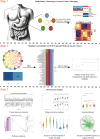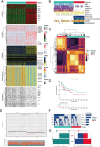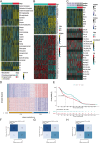Multiomics integration and machine learning reveal prognostic programmed cell death signatures in gastric cancer
- PMID: 39730893
- PMCID: PMC11680692
- DOI: 10.1038/s41598-024-82233-w
Multiomics integration and machine learning reveal prognostic programmed cell death signatures in gastric cancer
Abstract
Gastric cancer (GC) is characterized by notable heterogeneity and the impact of molecular subtypes on treatment and prognosis. The role of programmed cell death (PCD) in cellular processes is critical, yet its specific function in GC is underexplored. This study applied multiomics approaches, integrating transcriptomic, epigenetic, and somatic mutation data, with consensus clustering algorithms to classify GC molecular subtypes and assess their biological and immunological features. A machine learning model was developed to create the Gastric Cancer Multi-Omics Programmed Cell Death Signature (GMPS), targeting PCD-related genes. We verified the expression of the GMPS hub genes using the RT-qPCR method. The prognostic influence of GMPS on GC was then evaluated. Single-cell analysis was performed to examine the heterogeneity of PCD characteristics in GC. Findings indicate that GMPS notably correlates with patient survival rates, tumor mutational burden (TMB), and copy number variations (CNV), demonstrating substantial prognostic predictive power. Moreover, GMPS is closely associated with the tumor microenvironment (TME) and immune therapy response. This research elucidates the molecular subtypes of GC, highlighting PCD's critical role in prognosis assessment. The relationship between GMPS and immune therapy response, alongside gastric cancer's microenvironmental features, provides insights for personalized treatment.
Keywords: Gastric cancer; Machine learning; Multiomics; Prognosis; Programmed cell death.
© 2024. The Author(s).
Conflict of interest statement
Declarations. Competing interests: The authors declare no competing interests.
Figures










Similar articles
-
Multi-omics features of immunogenic cell death in gastric cancer identified by combining single-cell sequencing analysis and machine learning.Sci Rep. 2024 Sep 18;14(1):21751. doi: 10.1038/s41598-024-73071-x. Sci Rep. 2024. PMID: 39294296 Free PMC article.
-
Integrated multiomics analysis identified comprehensive crosstalk between diverse programmed cell death patterns and novel molecular subtypes in Hepatocellular Carcinoma.Sci Rep. 2024 Nov 11;14(1):27529. doi: 10.1038/s41598-024-78911-4. Sci Rep. 2024. PMID: 39528670 Free PMC article.
-
A comprehensive analysis of molecular characteristics of hot and cold tumor of gastric cancer.Cancer Immunol Immunother. 2025 Feb 4;74(3):102. doi: 10.1007/s00262-025-03954-z. Cancer Immunol Immunother. 2025. PMID: 39904894 Free PMC article.
-
Advances and applications of multiomics technologies in precision diagnosis and treatment for gastric cancer.Biochim Biophys Acta Rev Cancer. 2025 Jul;1880(3):189336. doi: 10.1016/j.bbcan.2025.189336. Epub 2025 Apr 29. Biochim Biophys Acta Rev Cancer. 2025. PMID: 40311712 Review.
-
Beyond Biomarkers: Machine Learning-Driven Multiomics for Personalized Medicine in Gastric Cancer.J Pers Med. 2025 Apr 24;15(5):166. doi: 10.3390/jpm15050166. J Pers Med. 2025. PMID: 40423038 Free PMC article. Review.
Cited by
-
Multiomics Signature Reveals Network Regulatory Mechanisms in a CRC Continuum.Int J Mol Sci. 2025 Jul 23;26(15):7077. doi: 10.3390/ijms26157077. Int J Mol Sci. 2025. PMID: 40806210 Free PMC article.
References
-
- Sung, H. et al. Global Cancer Statistics 2020: GLOBOCAN Estimates of Incidence and Mortality Worldwide for 36 Cancers in 185 Countries. CA Cancer J. Clin.71, 209–249 (2021). - PubMed
-
- Smyth, E. C., Nilsson, M., Grabsch, H. I., van Grieken, N. C. & Lordick, F. Gastric cancer. Lancet.396, 635–648 (2020). - PubMed
-
- Cristescu, R. et al. Molecular analysis of gastric cancer identifies subtypes associated with distinct clinical outcomes. Nat. Med.21, 449–456 (2015). - PubMed
MeSH terms
Substances
LinkOut - more resources
Full Text Sources
Medical
Miscellaneous

